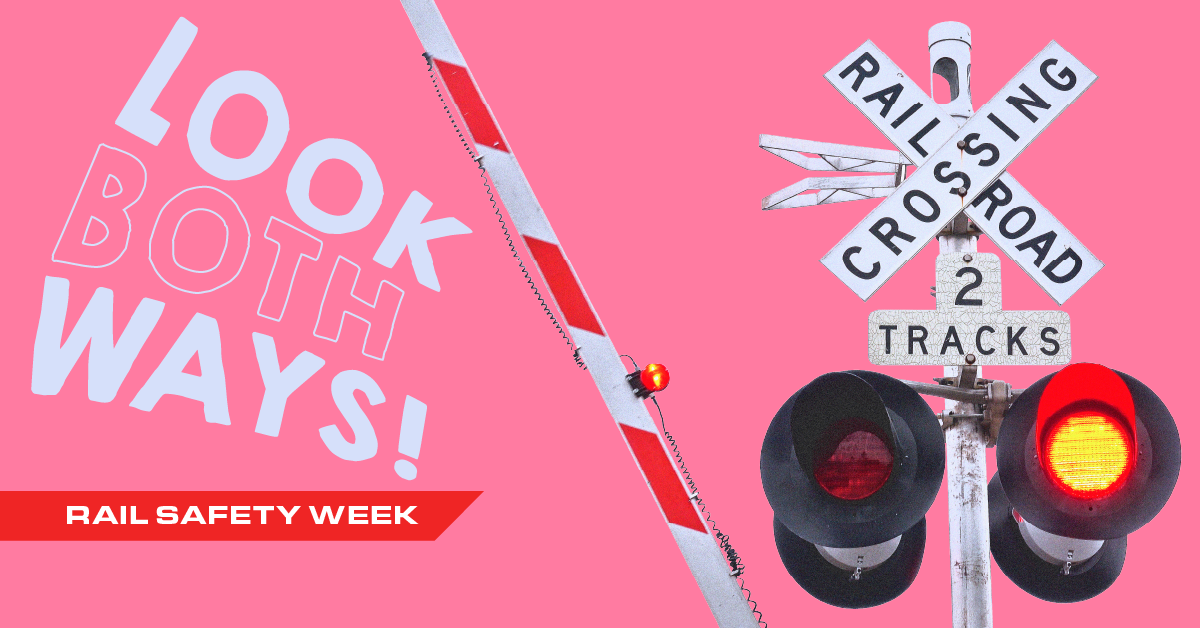Raising Awareness of Rail Safety
Did you know that federal statistics show that every three hours in the United States, a person or vehicle is hit by a train? These tragic and often fatal incidents are the motivators behind Rail Safety Week (RSW) in North America, an annual media awareness campaign led by Operation Lifesaver, Inc. (OLI). This year’s Rail Safety Week takes place from September 19 to September 25, with each day of the week emphasizing a different theme regarding rail safety. If you had the chance to read our August blog post about Traffic Safety Awareness Month, you know that Northeast Maglev takes safety seriously – and so should you!
You might already be aware of the dangers that railroad crossings can pose. But what you may not know is that over 50% of collisions occur at crossings equipped with lights and/or gates, as reported by the Federal Railroad Administration (FRA). Furthermore, rail-grade crossing collisions and pedestrian trespassing on tracks together account for over 95% of all railroad fatalities. What does this mean? Well, according to FRA and OLI, this data implies that most collisions can be attributed to poor driver/pedestrian judgment at grade level crossings. Seeing as over half of collisions occur at marked crossings, upgrading the tracks’ alarm and light systems can only go so far. That’s why RSW is so important, as it reminds drivers and pedestrians to make smart decisions around tracks.
OLI has been instrumental in reducing the number of train/motor vehicle collisions from a 1972 high of approximately 12,000 annual incidents to approximately 2,100 incidents in 2021. By promoting rail safety tips and raising awareness around largely preventable issues, these numbers can continue to decline. Some of OLI’s PSAs include reminders that might seem intuitive, but they are frequently forgotten, especially to those who navigate over or around tracks daily. It’s imperative to look both ways at railroad tracks and to always expect a train, as trains are often closer, quieter, and faster than they appear. Moreover, trains can run on many different tracks, at many different times, and from either direction. And most importantly, trains cannot swerve – so it’s on the driver or pedestrian to assess accurately the timing of crossing. Our team at Northeast Maglev is committed to safety on and off the clock, which is why we have all taken OLI’s Rail Safety Pledge: a promise to ourselves and others that we will make smart decisions around train tracks and spread the rail safety message.
While the FRA has reported that most collisions happen at marked crossings and are predominantly the result of driver judgment, this claim has not been without some questioning. Some have noted that yes, while many of these crossings are marked, the safety equipment present is often prone to malfunction due to weather or software issues and these elements are not fully factored into incident reports. Furthermore, the efficiency of marked crossings often relies on the interconnection between crossing lights and traffic lights. When traffic lights are properly tethered to railroad safety crossing devices, traffic at nearby intersections can be controlled to ensure the safety of motorists by avoiding backups onto railroad tracks. Thus, adequately sequencing traffic and crossing lights is instrumental in keeping the public safe. Of course, the FRA lacks the authority to mandate this type of interconnection at all railroad crossings. So, it’s up to passionate organizations like OLI to inform the public about the best safety precautions to take on an individual level. Meanwhile, we are eager to see how the relatively recent Railroad Crossing Elimination Grant Program (that we discuss in August’s blog post) will further improve and eliminate unsafe crossings.
Regardless of who bears the greater “responsibility” of crossing-grade incidents, it’s evident that grade level crossings can result in dangerous and often fatal situations. But compared to cars, trains can offer an exceptionally safer mode of transit for passengers, and with trains that have minimal grade-level crossings, safety can be ensured for more than just those on board.
Take, for example, the Tokaido Shinkansen (you may know it as the Bullet Train), Japan’s hugely popular and successful high-speed rail line. There have been no accidents resulting in fatalities or injuries to passengers onboard since operations commenced in 1964, despite traveling at an average of 145mph and carrying an average of 150 million passengers per year. The lines have been built without road crossings at grade, and tracks are strictly off-limits. The Superconducting Maglev (SCMAGLEV) will operate in a similar fashion, as it will travel in a dedicated guideway without any grade-level crossings. Like the Tokaido Shinkansen, the SCMAGLEV will use viaducts and tunnels that are fully separated from other modes of transportation. With the SCMAGLEV either fully above or below ground, this ensures that automobiles, pedestrians, animals, and non-SCMAGLEV trains cannot enter the guideway, thereby eliminating the possibility of collision.
It’s apparent that there needs to be more than one approach to stopping track tragedies. OLI has shown that raising awareness around track safety is not only effective, but also necessary. But as the U.S. population continues to climb and more drivers get on the road, it’s evident that our nation needs multi-faceted approaches to mitigate the impacts of grade level crossings. We are eager to see the benefits of investments like the Railroad Grant Elimination Program and regulation on a widespread scale to protect the public. Further, innovative projects like the SCMAGLEV that have safety principles embedded into the DNA of their operation can help steer the public in a safer (and faster!) direction.
